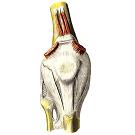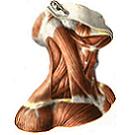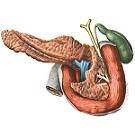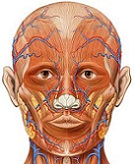Muscle, straightening the spine
The muscle that straightens the spine , m. Erector spinae, is the most superficial and is the most powerful and longest muscle in the back; It fills the entire length of the back with a depression along the sides from the spinous processes to
Corners of the ribs. The muscle begins from the back of the iliac crest, the dorsal surface of the sacrum, the spinous processes of the lower lumbar vertebrae and, in part, the superficial lumbar pectoral fascia. Going up, the muscle is divided into three parts in the lumbar region: the lateral iliac-rib muscle, the medial-awn muscle, and between them is the longest muscle.

A) The ileal-rib muscle, m. Iliosostalis, numerous muscular and tendon teeth attached to the corners of all ribs and transverse processes of the lower cervical vertebrae. Topographically, the following muscles are distinguished:
Ilio-rib muscle of the lower back, m. Iliocostalis lumborum, originates from the posterior part of the lateral sacral crest and the lumbosacral fascia and, moving to the side and upwards, forms 8-9 teeth, which are attached to the corners of the eight or nine lower ribs by thin narrow tendons;

Iliac-rib muscle of breast, m. Iliocastalis thoracis, starting near the corners of the lower five or six ribs, follows slightly obliquely up and out and is attached by thin narrow tendons to the corners of the upper five or seven ribs;
Ilio-rib muscle of neck, m. Eliasostalis cervicis, begins from the angles of five to seven upper ribs, is also directed obliquely upward and laterally and is attached to the posterior tubercles of the transverse processes of the IV, V, and VI cervical vertebrae by three prongs.
Innervation: rr. Dorsales nn. Spinales (CIII-CI; ThI-LI).
B) The longest muscle, m. Longissimus, is located medially from the ilio-rib muscle, extending from the sacrum to the base of the skull.

Topography in it differ:
Longest breast muscle, m. Longissimus thoracis, which starts from the posterior surface of the sacrum, the transverse processes of the lumbar and lower six or seven thoracic vertebrae, and, following upwards, is attached to the corners of the ten lower ribs and to the posterior sections of the transverse processes of all thoracic vertebrae;
The longest neck muscle, m. Longissimus cervicis, originates from the transverse processes of the four to five upper thoracic and lower cervical vertebrae, and, going upwards, is attached to the transverse processes of the vertebrae from axial to V cervical;
The longest muscle of the head, m. Longissimus capitis, begins from the transverse processes of the three upper thoracic and three to four lower cervical vertebrae, is directed upward and attached to the posterior margin of the mastoid process.
Innervation: rr. Dorsales nn. Spinales (CI-SII).
C) Spine muscle, m. Spinalis, is located along the spinous processes and topographically divides into a number of muscles:
A neural muscle of the breast, m. Spinalis thoracis, begins from the spinous processes of two or three upper lumbar and two or three lower thoracic vertebrae and, going upward, is attached to the spinous processes of VIII-II thoracic vertebrae;
A spinous neck muscle, m. Spinalis cervicis originates from the spinous processes of the two upper pectoral and two lower cervical vertebrae, and, proceeding upward, ends on the spinous processes of the upper cervical vertebrae - from IV to II;
The awning muscle of the head, m. Spinalis capitis, - a poorly developed part of the awned muscle, sometimes forms part of m. Semispinalis capitis or absent. It starts from the spinous processes of the upper thoracic and lower cervical vertebrae, is directed upward and is attached near the external occipital protrusion.
Function: the whole muscle, straightening the spine, m. Erector spinae, with bilateral contraction is a powerful extensor of the spinal column, keeps the trunk in an upright position. When unilateral reduction tilts the spine in the appropriate direction. The upper muscle tufts pull their head in their direction. Part of her bundles (m. Iliocostalis thoracis) she lowers the ribs.
Innervation: nn. Spinales (CI-SII).









Comments
When commenting on, remember that the content and tone of your message can hurt the feelings of real people, show respect and tolerance to your interlocutors even if you do not share their opinion, your behavior in the conditions of freedom of expression and anonymity provided by the Internet, changes Not only virtual, but also the real world. All comments are hidden from the index, spam is controlled.